Scottish household survey 2019: key findings
An infographic summary of the key findings from the 2019 edition of the Scottish Household Survey, a continuous survey running since 1999 based on a sample of the general population in private residences in Scotland.
Section Seven - Internet
In 2019, 88% of households in Scotland had access to internet.
This number had doubled since 2003, when the question was added to the survey.
The proportion of households with internet access differed between the deprivation level of the area where the household is located.
In the 20% most deprived areas in Scotland, only 82% of households had access to the internet, while 96% had access in the 20% least deprived areas.
The gap between the most and least deprived areas decreased since 2003.
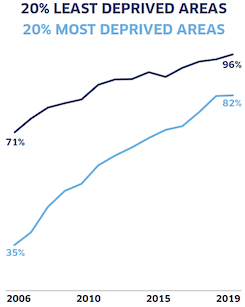
This line graph shows the proportion of households with access to internet in the most and least deprived areas in Scotland, and how it changed between 2006 and 2019. It highlights that internet access had increased significantly, both among the most and least deprived areas.
21% of adults in social housing did not use the internet
In contrast, only 5% of private renters and 10% of owner occupiers were not internet users
The proportion of internet users had increased since the questions were first asked in 2007, from 65% to 88% of all adults in 2019.
Among older people the proportion of internet users was significantly lower than the Scottish average.
Only half of those over 60 in the most deprived areas used the internet, while 83% of those over 60 in the least deprived areas did.
Among younger people the difference between area deprivation was smaller, but it was still significant.
96% of those between 16 and 34 in the most deprived areas used the internet, while 100% of those in the least deprived areas did.
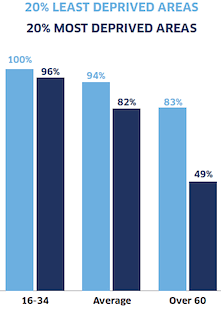
This bar chart shows the proportion of internet uses among adults of different age groups: adults aged 16 to 34 and aged 60 or over, as well as showing the average proportion of adults using the internet in Scotland. For each of these groups, it also shows the difference between the most and least deprived areas in Scotland. It highlights that there were more internet users among young people, and that among all age groups, there was a lower proportion of internet users in less deprived areas.
The proportion of internet users among those over 60 had increased from 29% in 2007 to 66% in 2019
This sharp increase was seen both in the most and the least deprived areas in Scotland
The most common device to access the internet was a mobile phone, such as a smartphone – with 86% of people accessing the internet this way.
For people over 75, the most common device to use to access the internet was a personal computer with 69% of people in this group doing it in that way.
For young adults between 16 and 24 years old, the most common way to access the internet was through a mobile phone, with 98% of adults accessing the internet this way.
Additionally, nearly all adults (97%) who used the internet access it at home.
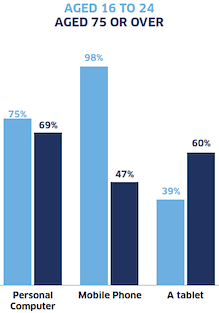
This bar chart shows the most common types of devices used to access the internet: a personal computer, a mobile phone and a tablet. For each of these devices, it shows the proportion of internet users using them in the age groups 16 to 24 and 70 or over. It highlights that younger adults were more likely to use a mobile, while older adults were more likely to use a tablet.
The proportion of adults who used internet for personal reasons when they were on the move increased from 30% in 2013 to 58% in 2019
Sending and receiving emails was the most common reason for personal use of the internet in 2019.
91% of internet users used the internet to send and receive emails, while 88% used it to search for information.
Buying goods or services, using social media and using internet banking were also among the most common reasons.
Adults living in social housing were less confident than adults in other forms of tenure in their ability to use the internet for activities such as ’sending and receiving e-mails’, ‘shopping online’, and ‘being able to tell what websites to trust.’’
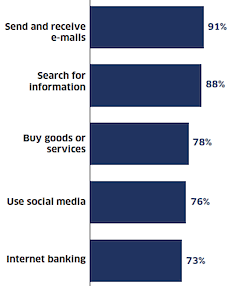
This bar chart lists the five most common reasons for personal use of the internet, and the proportion of adults giving these reasons. The following reasons are listed: Send and receive emails (91%), Search for information (88%), Buy goods or services (78%), Use social media (76%), and Internet banking (73%).
Making phone or video calls over the internet, and using online banking or social media are the three fastest growing reasons for using the internet since 2015
Only 9% of adults in Scotland had not taken any online security measures.
In the 20% most deprived areas, 18% had not taken any action for online security, while the equivalent number in the least deprived areas was 4%.
The most common measure for online security was to not open emails or attachments from unknown people, which 70% of adults reported.
The online security measures asked about in the survey were more likely to be taken by adults living in the 20% least deprived areas, as opposed to the 20% most deprived areas.
These measures were also more likely to be taken among younger age groups. 5% of those aged 16 to 24 had not taken any of the suggested actions, while 17% of those aged 75 or over had not taken any action.
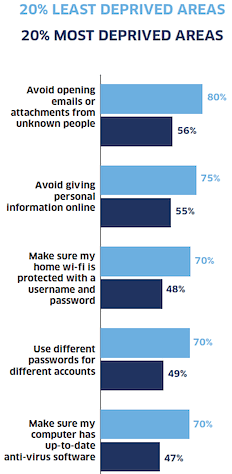
This bar chart shows the most common measures taken for internet security, ordered according to how common they are: “Avoid opening emails or attachments form unknown people”, “Avoid giving personal information online”, “Make sure my home wi-fi is protected with a username and a password”, “User different passwords for different accounts”, and “Make sure that my computer has up-to-date anti-virus software”. It shows the proportion of internet users taking these measures in both the most and least deprived areas. It highlights that more people took online security measures in the least deprived areas.
Contact
Email: shs@gov.scot
There is a problem
Thanks for your feedback